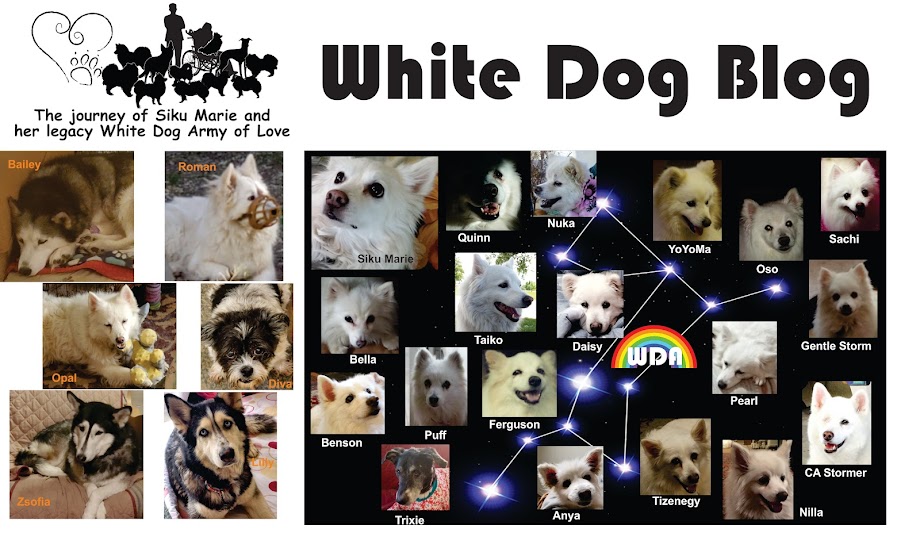Earlier, Taiko looked up at Steve when we entered the vet's office. The parking lot was full but the waiting room was nearly empty. All of the exam room doors were closed. "What's up?" he seemed to ask as Margaret, his favorite tech, hurried out from the back to take his lead and head back into the lab to draw blood.
When she returned Tai to us, she indicated that Dr. Julia would be out to see us in the lobby as soon as the blood work was analysed. The usual protocol is that we go into an exam room. In no time our amazing vet was out giving us the thumbs up and telling us all was back to normal. We quickly discussed the upper respiratory infection that half the White Dog Army seemed to be battling.
"It is everywhere," she said. "Like a Fall cold. Let's not give antibiotics; I prefer to let it run its course in three to five days. If they need it, use Robitussin Baby cough syrup. Chicken and rice if tummies get icky. Except Puff, I will go back and get something for her; we don't want her fighting anything respiratory. Here are also some drops for Taiko's eye, looks a little inflamed, he might be starting an infection in a tear duct or maybe scratched the corner of his eye."
Before she turned to go, I asked about the emptiness of the waiting room. "There is a bad parvo outbreak," she told us. "Oh, no socialization for Zsofia until it is over. Stay out of parks or places other dogs go. We are being extra careful here in the clinic. Asking folks to wait with their pets in their cars, washing everything down with bleach, carrying the young ones. Cindy came up with a great shoe cleaning system using a litter box and bleach soaked rags that we all step in as we enter and leave the exam rooms. Cannot be too careful with this. Wipe off your shoes and Tai's feet before you go into your house. Not to panic but to make sure Zsofia is safe; she still has one more booster to go."
I have been told that this outbreak is actually larger than just Albuquerque, and includes most of New Mexico and Texas. In the interest of increasing awareness, the WDA wants to share these facts about the disease; knowledge is a powerful tool in the fight for good health...
From Pets.WebMD.com: Parvo is a acute, contagious disease that dogs and cats can get. The disease is transmitted by oral contact with infected feces. Parvo can be carried on the dog’s hair and feet, as well as on contaminated crates, shoes, and other objects. Parvo affects dogs and cats of all ages, but most cases occur in those 6 to 20 weeks of age. Following an incubation period that averages four to five days, the acute illness begins with depression, vomiting, and diarrhea. Some dog have no fever, while others have high fever (up to 106°F, 41.1°C). Pups with severe abdominal pain exhibit a tucked-up abdomen. Diarrhea is profuse and contains mucus and/or blood. Dehydration develops rapidly.
Suspect parvo in all pups with the abrupt onset of vomiting and diarrhea. The most efficient way to diagnose parvo is to identify either the virus or virus antigens in stools. An in-office blood serum test (ELISA) is available for rapid veterinary diagnosis Puppies and dogs should not eat or drink until the vomiting has stopped. but require fluid support during that time. This can take three to five days. Antibiotics are prescribed to prevent septicemia and other bacterial complications, which are the usual cause of death.
The outcome depends upon the virulence of the specific strain of parvovirus, the age and immune status of the dog, and how quickly the treatment is started. Most pups who are under good veterinary care recover without complications.
Prevention: Thoroughly clean and disinfect the quarters of infected animals. Parvo is an extremely hardy virus that resists most household cleaners and survives on the premises for months. The most effective disinfectant is household bleach in a 1:32 dilution. The bleach must be left on the contaminated surface for 20 minutes before being rinsed. it is important to isolate young puppies as much as possible from other dogs and from potential sources of infection until they complete the parvo vaccination series at 16 weeks of age.
Currently, recommendations are for a booster a year from the initial vaccine series and then revaccination every three years.

4 comments:
Oh my, that is sure very scary!
So glad you have a thorough vet! Great advice and information. Thank you for sharing.
Be well and feel better soon, WDA!!!
wif lubbs from Little Reufus
We are so glad that Taiko's blood work came back good. That Parvo outbreak sure is scary, though. Thank goodness you have such a good vet, and know what you need to do to keep the WDA safe. Hugs, purrs and prayers to you all!
Parvo is so scary. I'm glad your clinic is being so careful.
And I'm glad that Taiko is doing well!
Post a Comment